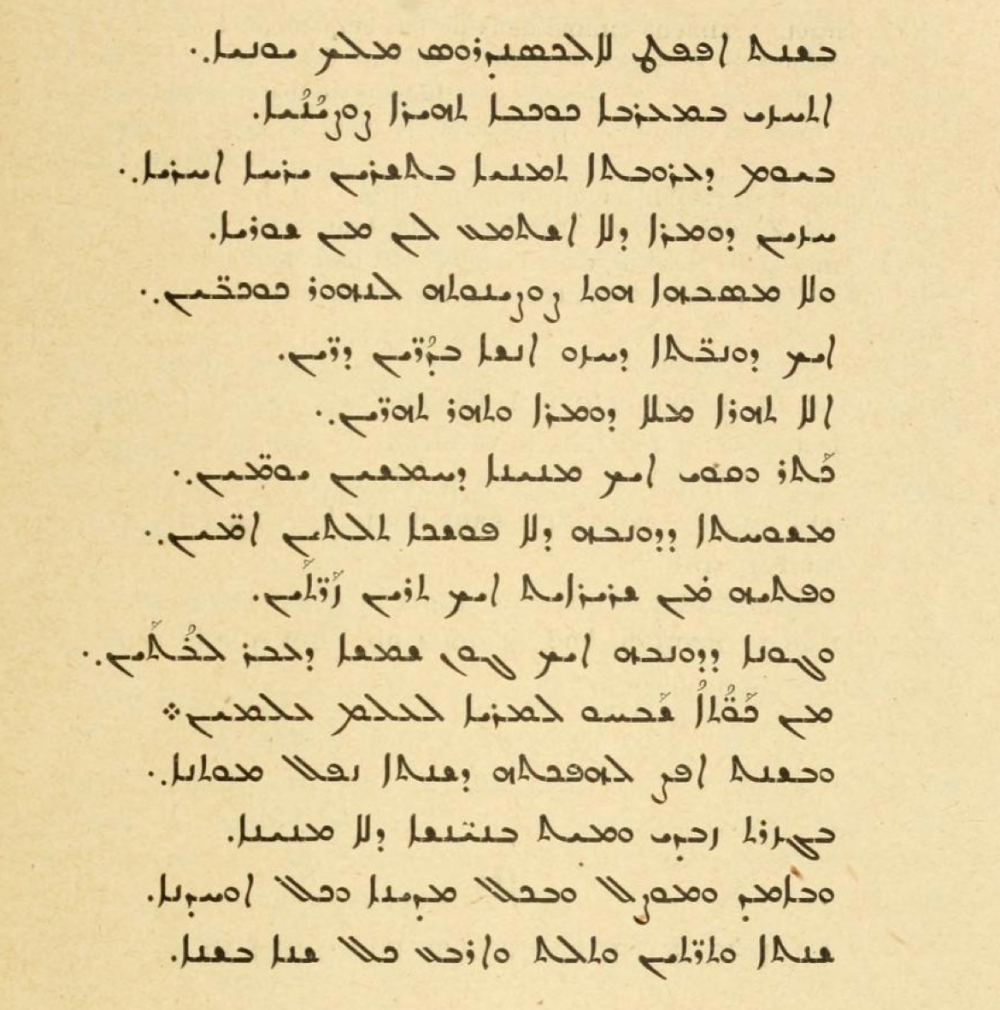(Apologia: Some background on the writing of this post. I wrote most of this post and translated the text when under the impression that there was not yet any English translation of it. I had stumbled upon Nau’s article while perusing the Syriac contents of ROC at Aramaico. But on the day I was finishing up the post, I happened to be looking at something completely unrelated in The Hidden Pearl, vol. 2, and I found to my surprise that there was a partial translation of this text in English! (If I had noticed it there before, I’d forgotten.) It will be found there on p. 258. Even though the translation below is not, then, the first English witness to this interesting text, it is, I think, the first complete English translation, and so I have decided to go ahead and share it. Being freely accessible online, it may also bring word of this text to a broader audience, and the other remarks and the vocabulary list will perhaps be of interest and use to some readers.)
Some time ago I published and translated two related notes in Syriac on some meteorological events from the sixteenth century (see also a later weather report in Syriac here). It happens that a more momentous sixteenth-century cosmic event, complete with a plague, was also recorded in Syriac: the Great Comet of 1577. The industrious François Nau first brought attention to the text with his publication and FT in his “Une description orientale de la comête de novembre de 1577,” ROC 27 (1929-1930): 212-214 (available here). Below I give the Syriac text, which is written in rhymed prose, followed by an English translation (which is not in rhymed prose!).
Comets are discussed here and there in Syriac cosmological literature. For example, in the Syriac version of the De Mundo, Sergius of Rēšʿaynā simply uses the Greek word (qwmṭʾ, qwmṭs; see McCollum, A Greek and Syriac Index to Sergius of Reshaina’s Version of the De Mundo, p. 104). Similar to the term below, Jacob bar Shakko has kawkbē ṣuṣyānāyē (see F. Nau, “Notice sur le livre des trésors de Jacques de Bartela, Évèque de Tagrit,” Journal Asiatique, 9th series, 7 (1896): 286-331, here 328). Similar is Bar ʿEbrāyā’s language in his “Book of Meteorology” in the Butyrum Sapientiae; see H. Takahashi, Aristotelian Meteorology in Syriac, pp. 148-149, 190-191. Via Bar ʿEbrāyā, too, we have the same terminology in a Syriac fragment based on “Ptolemy’s” Liber fructus; the fragment begins, āmar gēr Pṭolomos ba-ktābēh haw d-asṭrologia pērā qrāy(hy) (see F. Nau, “Un fragment syriaque de l’ouvrage astrologique de Claude Ptolémée intitulé le livre du fruit,” ROC 28 (1931-1932): 197-202, avail. here). (See further Payne Smith, Thes. Syr. col. 3382.)
The events here are dated beginning in Tišrin II, 1889 AG, which corresponds to November, 1577 CE. The plague at the end of the text is dated throughout the years 1890-1893 AG (= 1578/9-1581/2 CE).
In the year 1889 of Alexander, Greek king,
A marvelous comet appeared in the west.
On Friday, the 8th of the month Tišrin II,
We saw a wonder that we had never before heard of,
And its cometness was not like the light of stars,
[Nor] as the tails [of comets] that people had seen in various generations:
No, it was a marvel full of wonder and a marvel of marvels.
It lasted and continued about fifty days.
The size of its tail was undoubtedly thirty cubits,
And its width was surely about two of our spans.
The color of its tail was like the color of the sun, which crosses our houses.
From the windows praise the Lord forever!And in the year 1890 [AG], in the next year, a plague occurred
In Gāzrat Zabday, and numberless people died,
Also in Amid, Mosul, and in every city and every province:
[It lasted] a year, two, three, and four, each and every year.
For students of Syriac, here is a running list of vocabulary to the text:
ṣuṣyānāyā lock-like, having locks (of hair) < ṣuṣitā lock of hair (cf. “comet” κομήτης < κόμη)
dummārā marvel, wonder
sbh D to liken (here pass. ptcp)
ṣuṣyānutā cometness
dunbtā tail
te/ahrā wonder, miracle
puššākā uncertainty (d-lā puššākā certainly, undoubtedly)
ammtā cubit
zartā span (½ cubit)
ptāyā width
gawnā (cstr ES gon, WS gwan; see Nöldeke § 98) color, manner
bāttayn pl of baytā + 1cp
kawwtā window (in BibAram Dan 6:11)
hepktā d-ša(n)tā the following year
mawtānā plague, pestilence
Gāzrat Zabday cf. Payne Smith, Thesaurus Syriacus, cols. 702-703; Wright, Cat. Syr. Brit. Mus., vol. 3, p. 1339)
uḥdānā province
šnā abs of ša(n)tā

Leave a comment